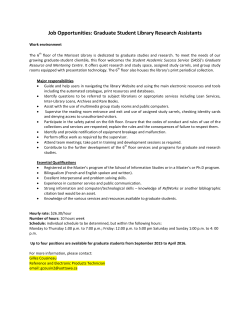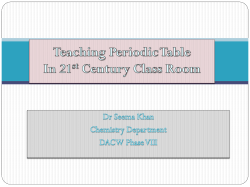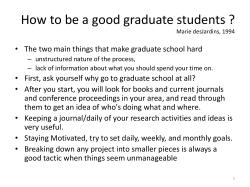
acknowledgments section
…It matters not how straight the gait… vi Acknowledgments I feel entitled to write this section with the intent of being comprehensive rather than succinct. It is the best opportunity I have to thank all of the people who have helped me throughout my graduate career, and probably the last good opportunity to express my gratitude, in writing, to the many individuals who have instructed and supported me throughout my formal education. First, I shall thank my graduate advisor, George Whitesides. His outline system for constructing scientific papers, his interest in communicating scientific ideas to diverse audiences, and his willingness to tackle some of the hardest problems in chemistry are aspects of George’s leadership that I admire and plan to emulate in the future. I thank Professors David Evans and Matthew Shair for serving on my graduate committee. I wish I had mustered the pluck to chat with them more often, but the conversations I did have were valuable. Professor Shair’s interest in thioesters and origin-of-life chemistry overlapped favorably with several of my research projects, and his knowledge of the origin-of-life literature is impressive. It was a particular honor to teach alongside Professor Evans in Chem 30 at Harvard. His commitment to students is unrivaled, and the slides for his lectures are an academic treasure. I also had the privilege of serving as a teaching fellow for Professors Gavin MacBeath (in Chem 27) and Christina White (in Chem 30). I thank them both for these enjoyable experiences. One of the principal reasons I decided to pursue graduate study at Harvard was the intellectual quality of the students. Indeed, I have had the privilege of working alongside several young scientists of the finest caliber. Since to thank everyone can be vii interpreted as thanking no one, I especially want to single out a select group of seven: Malancha Gupta, Declan Ryan, Brooks Bohall, Andrew Lee, Eric Mack, Adam Winkleman, and Ken Fraunhoffer. I am glad to count all of them as good friends. Malancha influenced my graduate career in an ineffably positive way. It was her interest in gels and paper that spawned our flurry of initial experiments that blossomed into four papers and a patent application in less than two years. We made a great team. The first half of this thesis is not mine—it is ours. Declan is an amazing scientist whose views of what the field should be doing are views I share. I can only hope I have the fortitude to put these ideas into practice when I have the chance. On our foray into the world of thioesters, it was Declan who taught me essentially everything I know about biology. Perhaps, one day, the dream of ThioTech will become reality. Brooks was a major player in the thioester story and a principal collaborator on our work with origin-of-life chemistry. For lack of a better term, Brooks is someone who “gets it.” He could always be counted on for an honest opinion, and his objectivity and clarity of thought in both scientific and social analysis were qualities I valued greatly. Andrew is a tenacious researcher that can always be counted on to help out and get things done. I am proud to have collaborated with him on several origin-of-life projects, and our co-consumption of obscene amounts of fast food fueled many late nights of lab work. I’m certain my life in the lab would have been miserable without Andrew’s camaraderie. viii Eric is a fantastic experimentalist and his work ethic is inspirational. He is also a hell of a lot of fun to be around. Adam’s self-effacing humor belies his depth of scientific knowledge and his ability to piece together really interesting projects. It was Adam who introduced me to ionotropic hydrogels, and in doing so, unexpectedly and amusingly shifted the focus of my research. Ken is a great organic chemist and a fantastic friend. Every grad student needs friends outside of his research group, both for technical expertise and mental sanity. The White Lab’s departure to Illinois was a real punch in the gut, but I’m glad we’ve kept in touch. I thank the many students with whom I have had the privilege of collaborating: Malancha and Eric on hydrogel films; Declan, Brooks, Phil Snyder, and Shawn Liu on thioesters; Andrew, Brooks, Darren Lipomi, Katie Gudiksen, and Nicola Ivica on originof-life projects; Vijay Krishnamurthy, Vincent Semetey, Eric, and Phil on protein-ligand binding; Michael Dickey and Darren on nanoskiving; and Adam and Irina Gitlin on magnetic gels. While I did not collaborate on projects with them, I also enjoyed working alongside Adam Urbach, Amy Wong, Bill Reus, Byron Gates, Charlie Mace, Derek Bruzewicz, Dorota Rozkiewicz, Doug Weibel, Emily Weiss, George Kaufman, Jerry Yang, Kat Mirica, Lara Estroff, Logan McCarty, Mamie Thant, Max Narovlyansky, Michael Harder, Michinao Hashimoto, Mila Boncheva, Mike Fuerstman, Piotr Garstecki, Qiaobing Xu, Raquel Perez-Castillejos, Roger York, Roman Boulatov, Sam Thomas, ix Sarah Vella, and Sindy Tang. I thank them for their collective expertise and general affability. Brooks Bohall, Eric Mack, Darren Lipomi, Andres Martinez, Sam Sia, Adam Urbach, Babak Amir-Parviz, Jinlong Gong, and Chao-Min Cheng were fantastic labmates and made Mallinckrodt 251 a great place to call home. I thank my colleagues who went above and beyond the call of duty in making things in the lab run by voluntarily tackling the most heinous tasks at clean-up, performing the leg work for group parties, and stepping up whenever the odd emergency arose. The true measure of their contribution is that the vast majority of these tasks were completed knowing that management would never learn of their involvement. Among the most helpful were Andrew Lee, Emily Weiss, Eric Mack, Raquel Perez-Castillejos, Phil Snyder, Sarah Vella, Malancha Gupta, Sindy Tang, Katie Gudiksen, and Irina Gitlin. If these people had not stepped forward to volunteer, the group would have been a much less cohesive unit and the lab would have been a less enjoyable place to be. The massive enterprise of the Whitesides Lab could not operate efficiently without the help of everyone in the office. I wince at calling them “office staff” because the term seems unable to convey a sufficient level of admiration or appreciation. Without them, the lab simply would not function. I thank Bob Holt for his devotion to making the lab a safer place, and T.J. Martin for his consummate professionalism and organization. I thank Sandy Rosen, Elisa Lenssen, and Launa Johnston for their help in figuring out schedules and getting on the calendar. I thank Melissa LeGrand for her help with papers, and Tracie Smart for keeping things running “behind the scenes,” so to speak. x It was a rewarding experience to have been part of the Harvard Origins-of-Life Initiative as one of its inaugural graduate fellows. Carol Knell does a great job of making sure things at the initiative run smoothly, and Dimitar Sasselov is a fantastic director. I can’t wait to see the heights to which he shepherds the program in the coming years. I thank both the Origins-of-Life Initiative and the National Science Foundation for the fellowships that supported my graduate study at Harvard. I am also grateful for the generous Samuel Morse Fellowship from New York University that supported both the cost of my undergraduate education and my research expenses. The Department of Chemistry and Chemical Biology sometimes seems like a behemoth machine designed to churn out scientific knowledge, and as students, we often take for granted those responsible for keeping the machine in working order. Tony Shaw adeptly managed what is perhaps the toughest job in the department, and I thank him for all of his advice throughout the years. Mark Gerstel and Anneka Lenssen were the smiling ambassadors of CCB seven years ago, and they were both incredibly helpful and great sources of information. John Randazzo and Pat Gall ran lab services impeccably. I shudder to think of how many tons of my mail they’ve had to sort. Chris Perry was awesome in general and is to be thanked for his daily deliveries of chemicals. Joe Pelrine and the rest of the VWR gang ran a great stockroom, and Marcia Chapin maintained a top-notch library. Francisco Pineda went above and beyond the call of duty in keeping our lab the clean, professional work environment that it is. Finally, I want to take a look back at several people who pre-dated my time at Harvard and had a profound influence on my academic pursuits. It was seventh grade where school became something very serious to me, and the high expectations and xi didactic rigor of Vern Williams kindled this fire more than anything else. Among highschool math teachers, Mr. Williams is a living legend—and deservedly so. His Math 7 and Algebra/Geometry classes fueled my competitive academic drive and helped lay the foundation on which my scientific knowledge is built. In high school, John Liebermann first exposed me to the subject of chemistry, and he is responsible for shaping how I approach learning new scientific material. Doc threw down a challenge in his accelerated AP Chemistry class by not only immersing us in difficult material, but by insisting we process it through understanding fundamental ideas and developing our “chemical intuition.” If it were not for Dr. Liebermann, I never would have entered the Westinghouse competition and benefitted from the fortuitous domino effect that ensued. Words cannot express how deeply privileged I am to be able to call David Schuster an advisor and a friend. There was something magical about working in his lab at NYU that solidified my interest in pursuing a career in chemistry. He was the consummate mentor: intelligent, honest, passionate, compassionate, and genuinely interested in his students and colleagues. Along with my family, no one has been more supportive of me, through both the good times and the hard ones. David is the touchstone for what I value in an advisor. And behind everything, throughout the entire journey, I have benefitted immensely from the support of friends and family. My parents exposed me to all sorts of opportunities as I grew up, and they were incredibly encouraging of all I wanted to do. While I could expound on their impact on my life for several more pages, I can just as xii easily summarize their meaning to me in a single sentence: a kid couldn’t ask for a better Mom and Dad. They were perfect parents. Outside of my chemical life, I have also been able to draw support from close friends like Romana Moreno and her family, Brad Forrest and his family, and Chris Denny. These deep friendships have meant a great deal to me. Any future success that I may enjoy will be built on the educational foundation laid by all of those mentioned above. The extent to which I feel indebted to them is humiliating, and as I emerge from my formal education and look to start contributing to the world in earnest, I will never forget the large debt I owe to these benefactors and to society. I’m eager to start paying everyone back. xiii
© Copyright 2025










